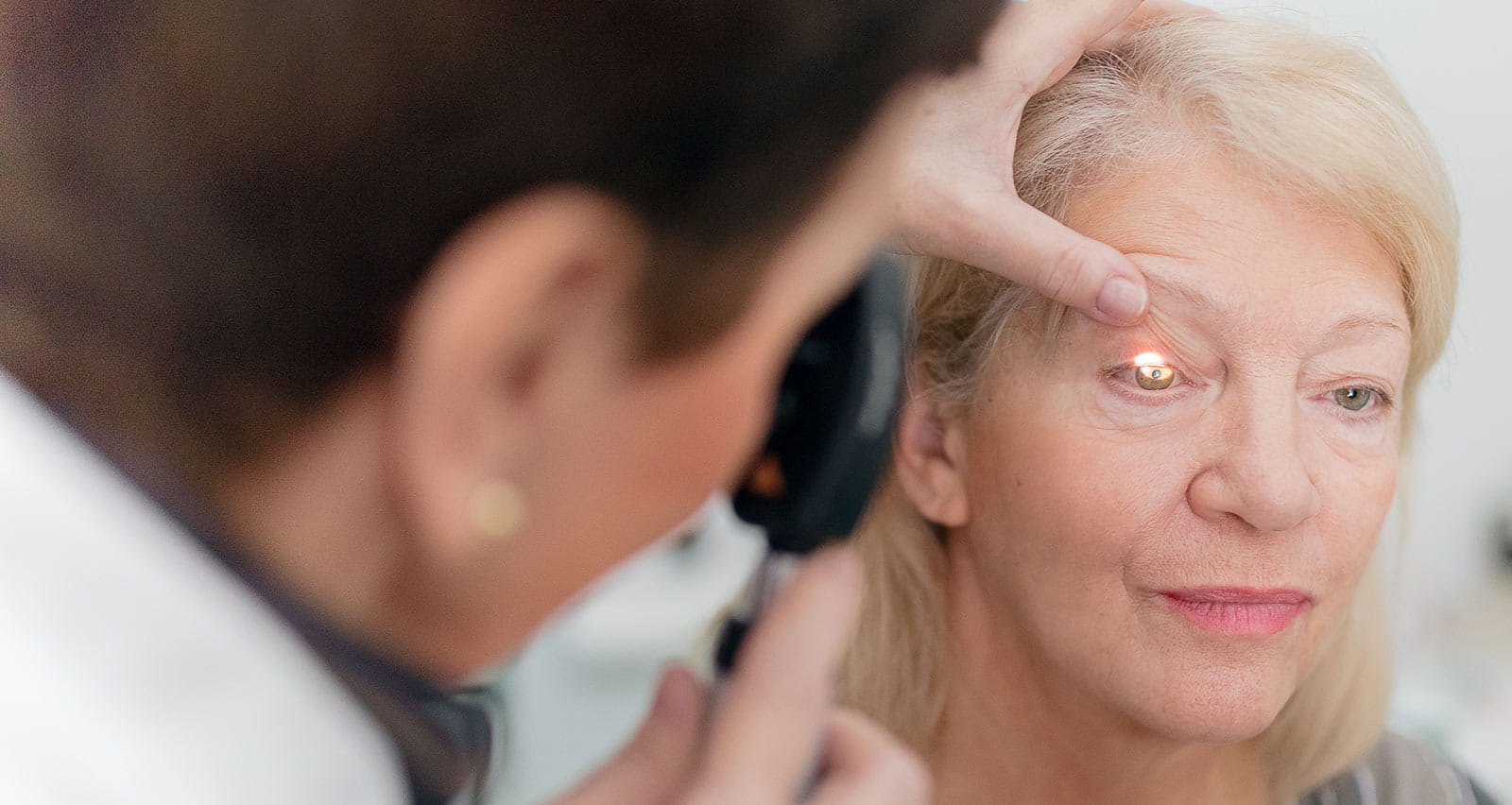
Retina and Macular Disease
The Center for Retinal and Macular Diseases and Surgery at University Hospitals Eye Institute diagnoses and treats all eye diseases and conditions affecting the:
- Retina: The light-sensitive layer at the back of the eye that detects light and converts it into electrical signals that are sent through the optic nerve to the brain, where they are processed into vision.
- Macula: Located at the center of the retina, the macula is a small and highly sensitive area of the retina that is responsible for detailed central vision.
- Vitreous Humor (or Vitreous): The clear, jelly-like substance that fills the inside of the eye.
- Choroid: The layer of blood vessels and connective tissue between the white of the eye (sclera) and retina.
Your health is important. Get expert care.
Call 216-844-3937 today to schedule an appointment.
Patients With Diabetic Retinopathy
Diabetes is the leading cause of blindness. When it occurs, it creates a vision-impairing condition called diabetic retinopathy. In Cuyahoga County, 1 in 13 residents are afflicted with diabetic retinopathy and this number continues to grow. Each year you have diabetes increases your chances of developing diabetic retinopathy.
Our retina specialists are skilled at detecting the early stages of the disease, which often occur without any vision loss or other obvious symptoms. Through a comprehensive vision screening exam with eye dilation, we we’re able to look at the back of the eye and see any swelling, fluid deposits or other changes that indicate the presence of early-stage (nonproliferative) or advanced-stage (proliferative) diabetic retinopathy.
Patients With Age-Related Macular Degeneration
Macular degeneration is the most common cause of vision loss in people 50 and older. The disease affects the macula, which maintains the sharpness of your central vision, allowing you to see fine details when you look at something directly in front of you. Although it rarely causes total blindness, macular degeneration can make driving, reading, recognizing faces and doing close-up work difficult.
Our ophthalmologists are trained to detect the two main types of macular degeneration –wet and dry – each of which has different causes. We work with you to prescribe the right treatments to slow down and minimize vision loss.
Other Retinal, Macular & Related Conditions
Other retinal, macular and related conditions we diagnose and treat include the following:
- Acute Retinal Necrosis
-
Acute retinal necrosis (ARN) is an infection of the retina caused by herpes viruses, most often the varicella zoster virus. The disease causes retina cells to die and a high degree of inflammation in the eye. Symptoms can include eye pain, light sensitivity, floaters and flashes, blurred vision, loss of visual clarity or a narrowed visual field. ARN can lead to retinal detachment, vision loss and blindness if left untreated.
- Central Retinal Vein Occlusion (CRVO)
-
A central retinal vein occlusion (CRVO) is when the main retinal vein becomes blocked, causing blood and fluid to spill out into the retina. As a result, the macula can swell and affect your central vision. Eventually, without blood circulation, nerve cells in the eye can die, causing more vision loss.
- Central Serous Chorioretinopathy
-
Central serous chorioretinopathy, also referred to as CSCR and CSC, is a condition in which fluid accumulates under the retina to cause a serous (fluid-filled) detachment and vision loss. CSCR most often affects young and middle-aged adults and men more than women. Vision loss caused by CSCR is usually temporary but sometimes becomes chronic or recurs.
- Choroidal Nevus
-
Similar to a freckle or mole, a choroidal nevus is darkly pigmented lesion found in the back of the eye. Usually a choroidal nevus does not cause any symptoms and is detected in a routine eye exam. However, sometimes choroidal nevi that form under the macula can cause blurred vision.
- Cystoid Macular Edema
-
Cystoid macular edema (CME) is a condition in which multiple cyst-like (cystoid) areas of fluid appear in the macula, causing the retina to swell. CME is a painless condition but can cause blurred or decreased central vision. Although the exact cause of CME is unknown, the condition can accompany other diseases such as retinal vein occlusion, uveitis and diabetes. It most commonly occurs after cataract surgery.
- Epiretinal Membrane
-
An epiretinal membrane (ERM) is a tissue-like scar or membrane that forms on top of the retina, sometimes including the macula. When it forms over the macula, an ERM can cause distortion and blurring of the central vision. ERMs typically occur in people after age 50 and most commonly in adults 75 and older. Various conditions can cause or contribute to an ERM, including diabetic retinopathy, uveitis, retinal detachment or tearing and eye injury.
- Floaters and Flashes
-
Eye floaters (myodesopsias) are shapes – usually squiggly lines, dots or threads – that you may see when you look at a clear sky, a white wall or a blank piece of paper. You may also see flashes of light (photopsias) at the same time you see floaters. Both floaters and flashes occur when the vitreous humor (the gel-like substance in the middle of the eye), lifts up from the surface of the retina and pulls on it, producing tension.
Floaters are solid pieces of the vitreous humor that move around in the liquid vitreous humor. They are like tiny bits of dust stuck on a camera lens: If you try to blink them away or look somewhere else, they will still be there. Floaters are more likely to happen with age and often do not need treatment. If you experience a sudden onset of many floaters or flashes, you should see an eye care provider.
- Hypertensive Retinopathy
-
Hypertensive retinopathy is a condition where long-term high blood pressure causes damage to your retinas. The condition does not cause symptoms until the advanced stages, when you may begin to experience vision loss or other complications. Maintaining your blood pressure at a healthy level with lifestyle changes and medications can help prevent hypertensive retinopathy.
- Macular Hole
-
A macular hole is a small break that forms in your macula. As the hole forms, objects in your central vision begin to look blurry, distorted or wavy. As the hole continues to grow, a dark spot will appear in your central vision. Macular holes are usually caused by aging. As you get older, the vitreous humor starts to shrink and pull away from the retina. Sometime when this happens, the vitreous humor can stick to the retina, causing the macula to stretch and a hole to form. Macular holes can be treated with vitrectomy, a surgical procedure for the removal of some or all of the vitreous humor from the affected eye.
- Posterior Vitreous Detachment (PVD)
-
A natural change that occurs during adulthood, posterior vitreous detachment (PVD) is when the vitreous humor (the gel-like substance in the middle of the eye) separates from the retina, causing floaters and flashes. Symptoms usually ease up over several weeks. PVD isn’t painful or sight-threatening, but if you have symptoms, you should consult an eye doctor to make sure you don’t have another retina condition.
- Progressive outer retinal necrosis (PORN)
-
Progressive outer retinal necrosis (PORN) is infection of the retina typically caused by the varicella zoster virus. The infection causes tissue death of the outer layers of the retina and eye inflammation. Symptoms can include loss of visual clarity, blurred vision, floaters and flashes, and a narrowed visual field. PORN progresses very rapidly and can lead to retinal detachment, vision loss and blindness if left untreated.
- Retinal Artery Occlusion
-
A retinal artery occlusion (RAO) is when a blood clot or cholesterol builds up and blocks blood flow in one or more of the retina’s arteries. A blockage in the small arteries in the retina is called a branch retinal artery occlusion (BRAO), while a central retinal artery occlusion (CRAO) is when the central artery in the retina becomes blocked. Regarded as a form of a stroke in the eye, a CRAO is a risk factor for having a brain stroke and is considered a medical emergency.
- Retinal Detachment
-
Retinal detachment is when the retina separates from the layer of blood vessels at the back of the eye that provides oxygen and nourishment to the eye. Symptoms can include reduced central and side vision and the sudden appearance of dark floating shapes and flashes of light. Retinal detachment is a medical emergency. The longer retinal detachment goes untreated, the greater the risk of permanent vision loss in the affected eye. Contacting an eye doctor as soon as symptoms develop can help save your vision.
- Retinal Tear
-
A retinal tear or break occurs when the gel-like vitreous humor in your eye pulls on your retina and creates a hole. A retinal tear is less serious than retinal detachment, but still needs treatment. Symptoms may include blurry vision and a large amount of eye floaters and flashes. Your eye care provider can repair a retinal tear before it leads to a detached retina.
- Retinitis Pigmentosa and Other Chorioretinal Dystrophies
-
Chorioretinal dystrophies are a group of hereditary eye diseases that affect the retina and/or the choroid. Examples of chorioretinal dystrophies are retinitis pigmentosa, Stargardt-Fundus-Flavimaculatus disease, Best vitelliform dystrophy, cone dystrophy and patterned dystrophy. The most common chorioretinal dystrophy is retinitis pigmentosa, which is a group of eye diseases that affect the retina. Retinitis pigmentosa causes cells in the retina to break down slowly over time, leading to vision loss that progresses over the years. The first vision changes associated with the condition usually start in childhood. These early signs and symptoms include problems with night vision and seeing in dim light and blind spots in peripheral vision.
- Sickle Cell Retinopathy
-
Sickle cell retinopathy is an eye disorder that affects some people with sickle cell disease. It is characterized by blockage of blood vessels in the retina and choroid that cause an abnormal growth of blood vessels and a thinning of the retina. Early damage from sickle cell retinopathy usually does not affect vision, but the condition can cause eye problems to develop over time if left untreated.

Clinical Trials
University Hospitals Cleveland Medical Center and Case Western Reserve University are leaders in research of retinal degeneration and diabetic retinopathy. Our team is working on new research to idenfity early signs and causes of these conditions and diseases. In addition to conventional treatment approaches, patients also have opportunities to participate in clinical trials offering pioneering therapeutics.


